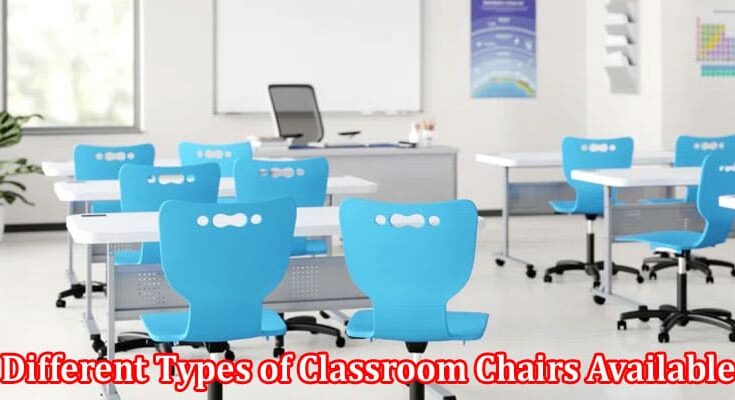Creating an optimal learning environment involves various factors, and one often overlooked aspect is the choice of seating. It’s important to make sure your students are comfortable, or it makes harder for them to get word done. Chairs built for a classroom play a vital role in promoting comfort, focus, and engagement among students. Knowing what the different classroom options serve helps you to invest in the right chairs for your students. By understanding these options, educators can provide students with seating choices that cater to their diverse learning needs and preferences. Which helps you, as the educator, get important work done promptly.
Traditional Chairs:
Traditional chairs provide a reliable and cost-effective seating solution. A common seating option that is practically found in every school. If you have been inside a classroom, these are the type of classroom chairs you would find. These chairs typically have a sturdy frame made of metal or plastic, featuring a flat seat and a backrest. Traditional chairs are durable, cost-effective, and provide adequate support for students during extended periods of sitting. However, they can get uncomfortable after a certain amount of time. These are great for students who are in your classroom for shorter periods of time.
Ergonomic Chairs:
Recognizing the importance of student well-being and posture, ergonomic chairs have gained popularity in recent years. These chairs are specifically designed to support the natural curvature of the spine and promote healthy sitting habits. These chairs often feature adjustable components such as seat height, lumbar support, and contoured seat and backrests. Ensuring proper alignment and reducing the risk of musculoskeletal issues. By providing optimal support and comfort, ergonomic chairs help reduce physical strain and enhance student focus. This type of chair is particularly beneficial for students who spend long hours seated, such as during exams or intensive study sessions.
Stools and Standing Desks:
Introducing movement and alternative seating options in classrooms can have a positive impact on student engagement. Stools and standing desks offer dynamic choices for learners who benefit from a more active learning environment. Stools are backless seats that encourage an upright posture and allow for greater mobility. They enable students to move and shift their weight, promoting improved blood circulation and preventing stiffness. Standing desks, on the other hand, provide the flexibility of standing or perching on a stool while working. These options promote better blood flow, increased energy levels, and improved concentration, especially for students who find it challenging to sit still for extended periods. This option not only increases energy levels but also supports better concentration and focus.
Soft Seating:
For collaborative activities, reading corners, or relaxation zones within the classroom, soft seating options provide a cozy and inviting environment. This type of seating is popular amongst classrooms with younger students. But older students can also enjoy the benefits of comfortable seating. Bean bags, floor cushions, and upholstered chairs offer a more relaxed seating experience, allowing students to unwind while engaging in group discussions or independent reading. The soft materials and casual designs create a comfortable atmosphere that encourages interaction and creativity. Soft seating options can be particularly useful for promoting a sense of community and fostering social connections among students.
Wobble Chairs and Exercise Balls:
Designed to promote movement and core engagement, wobble chairs and exercise balls are gaining popularity in classrooms. Wobble chairs have rounded bottoms that allow for gentle rocking or tilting motions, which help activate the body’s core muscles. The subtle movements promote increased focus and attention while providing a way for students to release excess energy. Exercise balls, also known as stability balls, provide an unstable surface that encourages students to make constant micro-adjustments to maintain balance. This engagement of core muscles promotes better posture and strengthens the core over time. The use of wobble chairs and exercise balls in the classroom can create a more dynamic learning environment that supports physical well-being and enhances student engagement.
Conclusion
The selection of school chairs should go beyond mere functionality. As an educator, you want to make the best choices for your students and classroom. Considering these different factors for these chairs can make all the difference. Whether it’s providing ergonomic chairs for optimal posture, incorporating stools, and standing desks for active learning, introducing soft seating for collaboration and relaxation, or implementing wobble chairs and exercise balls to promote movement, each option contributes to a well-rounded and dynamic classroom experience. Creating an environment that is comfortable for your students gives them the time and space to focus on their activities. With a calm classroom, educators are better prepared to get through the day without having to worry about their students.

Caroline is a dedicated writer with a passion for keeping readers informed. Specializing in providing the latest news updates and unbiased reviews, she strives to deliver accurate and insightful content. With a keen eye for detail and a commitment to journalistic integrity, Caroline ensures that her readers are always well-informed. Stay tuned for her latest articles to stay up-to-date on current events and trends.




